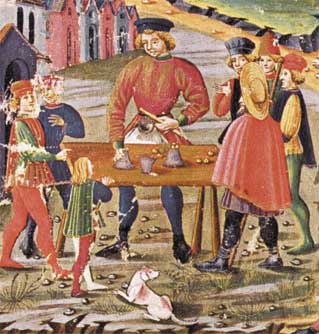 |
 |
 |
 |
| Untitled Triumph Card
Bonifacio Bembo, c.1455 |
The Conjurer from
Children of the Moon Cristoforo de Predis, c.1460 - 1470, De Sphaera of Iohannes Sacrobosco, made for Francesco or Galeazzo Maria Sforza. |
Triumph card, c. 1475,
belonging to the Este family, Dukes of Ferrara. |
Triumph card, c. 1475,
belonging to the d'Este family, Dukes of Ferrara (drawing of the previous card in d'Allegmagne 1906, from Kaplan, 1978). |

|

|

|

|
"Master of the Medieval Hausbuch"
c. 1475-1490 www.humanist.de/rome/housebook www.frick.org/html/medieval.htm www.origrafica.com/research/art11_1.asp |
"Bagatella" card from
an uncut sheet, c.1500 Cary Collection, Beinecke Library, Yale University |
Conjurer from
Children of the Moon, in the Seven Planets of Hans Sebald Beham, c. 1530-40 |
Le Bateleur Tarot de Catelin Geoffrey 1557 |

|

|
| Il Bagatino Late 15th - early 16th century, Ferrara or Florence, Rosenwald Collection, National Gallery of Art, Washington D.C. |
Le Bateleur, "Anonymous Parisian Tarot" early 17th century, Bibliothèque Nationale de France Paris |
In these figures from the 15th and 16th century, note that (except for the Rosenwald) the Conjurer has on his table very prominent balls or coins, along with cups, usually two but sometimes three, accompanied by other small objects for doing tricks.
Note also the strength of the tradition that makes the Conjurer's costume red and green, or some other dark colour, and that in the majority of cases he holds his wand in his left hand, while manipulating the cup with his right.
Charles Zika explains the 15th century significance of the figure of the Conjurer in his paper at
www.zeitenblicke.historicum.net/2002/01/zika/zika.pdf
"A figure at a table with cups, balls and a stick or wand, appears in numerous so-called "Children of Luna" images through the fifteenth and early sixteenth centuries. One of the fashionable and novel forms of social analysis and commentary in this period was to link social classes, occupations, professions, societal groups, and even psychological profiles and states, with astrology - with the planets and signs of the zodiac. In this way conjurors were linked to sailors, fishermen, fowlers, millers, bathers and vagrants; for all were considered to share in the cold and moist qualities of the moon. They were the children of Luna and manifested the fluidity and speedy movement of the moon, in their fickle, capricious, unstable and independent behaviour and nature. The conjuror with his cups and balls, who features so prominently in most of these images, clearly merits his identification with Luna because of two characteristics: firstly, he represents the archetypal vagrant, travelling from fair to fair for his living; and his living, and by virtue of that his identity, is premised on the manipulation of reality by the use of trickery, illusion and falsehood. We find illustrations of a conjuror with cups and balls on a table as a central figure in Children of Luna images from as early as 1404 - in a Tübingen manual on astrology and medicine - and their number increases through the fifteenth and early sixteenth centuries. In the fifteenth century they are found in several German manuscripts, in an engraving by Baccio Baldini of c. 1460, and then
in several block books from the 1460s and 70s. A block book now in Berlin (fig. 4) possibly provided the model for the most well known and exquisitely executed of these images, that from the so-called "Medieval Housebook", an illustrated manuscript completed between 1475 and 1485 by an artist simply known as The Housebook Master or the Master of The Amsterdam Cabinet."